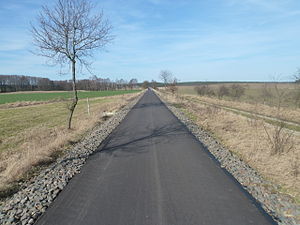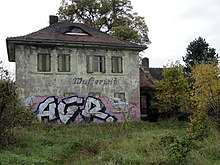Railway line Wusterwitz – Görzke
| Wusterwitz – Görzke | |||||||||||||||||||||||||||||||||||||||||||||||||||||||||||||
|---|---|---|---|---|---|---|---|---|---|---|---|---|---|---|---|---|---|---|---|---|---|---|---|---|---|---|---|---|---|---|---|---|---|---|---|---|---|---|---|---|---|---|---|---|---|---|---|---|---|---|---|---|---|---|---|---|---|---|---|---|---|
|
The southern part of the route is now a cycle path,
the gravel has been preserved. | |||||||||||||||||||||||||||||||||||||||||||||||||||||||||||||
| Route number : | 6886 | ||||||||||||||||||||||||||||||||||||||||||||||||||||||||||||
| Course book range : | 705 (1968) | ||||||||||||||||||||||||||||||||||||||||||||||||||||||||||||
| Gauge : | 1435 mm ( standard gauge ) | ||||||||||||||||||||||||||||||||||||||||||||||||||||||||||||
|
|||||||||||||||||||||||||||||||||||||||||||||||||||||||||||||
The Wusterwitz – Görzke railway , also called Buckautalbahn , was a single-track branch line in what is now the state of Brandenburg . It was in operation for passenger traffic until the early 1970s, while freight traffic was maintained on the southern section of the line until the 1990s. The remnants of the route between Rogäsen and Görzke and a locomotive parked in Görzke station are listed as a cross-site monument "Buckautalbahn" on the list of monuments of the state of Brandenburg, the reception building and several auxiliary buildings of the Ziesar station are listed as individual monuments.
history
Prehistory and construction
In 1896 the city of Ziesar had a railway connection with a line of the narrow-gauge small railways of the Jerichow I district from the direction of the castle . However, the local economy was more interested in a connection in the direction of Brandenburg an der Havel . Original plans provided for a further construction of the narrow-gauge railway in the direction of Brandenburg, but this was not realized. In Ziesar the railway line had been prepared accordingly, the trains from Burg ended after they had passed the Ziesar West station on the north-western edge of the city center, in a Ziesar Ost station on the outskirts of the planned extension to Brandenburg. To the east of Ziesar there had already been some preparatory work for the route extension. The further construction in the direction of Brandenburg failed mainly due to the resistance of the city of Burg, which feared competition for the local traders.
Later one saw advantages in a regular lane connection to the city also in Ziesar. Especially for the pottery and clay industry, which is widespread in the Ziesar and Görzke area, reloading between narrow and standard-gauge wagons was seen as a hindrance. On May 21, 1901, the Kleinbahn-AG Ziesar - Großwusterwitz (KZG) was founded and opened the line from Großwusterwitz (today Wusterwitz ) on the Berlin – Magdeburg line to Ziesar on October 1 of the same year . The company Lenz & Co. , which had also acquired a stake in the KZG, initially took over the management . In the first few years the KZG transported 13,000 people and 4,700 tons of goods and generated an operating surplus of 5,600 marks. The original station in Ziesar was next to the end point Ziesar Ost of the narrow-gauge railway in the northeast of the city, well outside the center. In 1908 the management of the KZG was transferred from Lenz & Co. to the small railway department of the Provincial Association of Saxony in Merseburg .
Extensions
On August 11, 1911, the now Kleinbahn-AG Großwusterwitz - Ziesar - Görzke (from 1914 Ziesarer Kleinbahn ) company extended the route to Görzke . On February 4, 1912, a short branch line from Rogäsen to Karow went into operation. The places west of Ziesar also called for a connection to the railroad. Due to the First World War , the construction of the railway line from Ziesar to Güsen on the Berlin-Magdeburg Railway was delayed for some time. On September 15, 1916, the section from Ziesar to Tucheim went into operation for freight traffic and on October 21 for passenger traffic; on April 2, 1917, the entire line to Güsen was completed. The KZG was renamed the Ziesarer Kleinbahn . In 1915/16 the company carried 36,000 passengers and 76,500 tons of goods.
In connection with the new line to Güsen, the train station in Ziesar was relocated 800 meters to the south closer to the city center, and the integration of the narrow-gauge line was adjusted accordingly. The new station was called Ziesar Hauptbahnhof . In 1923 the Ziesarer Kleinbahnen merged with the Genthiner Kleinbahnen to form the Kleinbahn AG Genthin-Ziesar . In the 1920s there were other projects to extend the network, including from Görzke to Wiesenburg (Mark) station , but these were not implemented. Some of these projects had already been designed when the line to Görzke was being built and were discussed again in the 1930s. The tracks at Görzke station had already been designed for a possible extension. Also planned, but not implemented, was the re-gauging of the narrow-gauge network. Passenger traffic on the narrow-gauge railway ended as early as 1930 at the Ziesarer Westbahnhof, so that there was no longer any direct link to the regular gauge trains. After the end of the Second World War , goods traffic on the narrow-gauge railway also ended in Ziesar West.
After the Second World War
Traffic between Wusterwitz, Ziesar and Görzke was resumed after the end of the war on May 22, 1945. The branching line was shut down in 1951 and then dismantled. As part of an administrative reform in 1952, the places on the route that previously belonged to the district of Jerichow II (from 1950 district of Genthin ) in the province of Saxony (from 1947 to the state of Saxony-Anhalt ) became part of the Potsdam district and thus in 1990 to the state of Brandenburg .
With the expansion of the road network and the corresponding bus traffic, the demand for passenger traffic gradually declined. Passenger traffic between Wusterwitz and Ziesar ended on May 23, 1971, and between Ziesar and Görzke on September 29, 1973. The northern section of the line was then dismantled from Wusterwitz. Because of a defective dismantling crane, you could only get as far as 6.3 km. The remaining track was used to park freight cars.
The southern section of the route continued to operate in freight traffic, with Ziesar then only being reached via Güsen. Above all the Soviet army in Buckau and near Ziesar as well as the wood processing in Görzke provided for the freight traffic. After the turnaround and with the withdrawal of the Soviet armed forces, freight traffic between Ziesar and Görzke was discontinued in 1994 and the section was closed on April 30, 1996. The shipping site of the companies Quelle and Schöpflin in Bücknitz , which was set up after the German reunification in 1989, used the siding for freight traffic. The section from there to Ziesar was also officially closed on October 31, 1999. The Ziesar station remained in operation for trains from Güsen until 1999. After the rails were dismantled in 2003 as a result of theft, the remaining parts of the route were placed under monument protection at the end of 2004. In 2011 a cycle path was opened on the southern section of the route.
Passenger traffic was only moderate during the entire operating time of the line and, depending on the section of the route and the day of the week, usually amounted to four to five pairs of trains a day. Only some of the trains ran continuously over the entire route, the others only ran between Wusterwitz and Ziesar or Ziesar and Görzke or had long idle times in Ziesar.
Route
The line began at Wusterwitz station (until 1952 Großwusterwitz ) south of the state railway station. The Kleinbahn had its own station building. It still exists, but has not been used (as of early 2012). From there, the line ran parallel to the state railway to the west, then turned to the southwest towards Warsaw and further south to Rogäsen. There the line turned back west to the Rogäsen train station, which was located well outside the village (initially Rogäsen-Zitz , after the Second World War temporarily called Rögäsen (b Magdeburg) ). The station initially had two through tracks and was extended by a third track when the line to Karow was built. The reception building no longer exists; today there are facilities for a waffle factory.
While behind Rogäsen the route to Karow ran westwards, the route to Görzke turned south and ran through the Fiener Bruch to Bücknitz. The station building there no longer exists, but some track systems with the connection to the former Quelle warehouse have been preserved. From there the route continued to Ziesar. The Ziesar reception building at the junction of the roads to Bücknitz and Brandenburg, which was used until 1916, is now a residential building. 800 meters south of it is the later Ziesar train station, called Ziesar Hbf from 1916 to the mid-1960s . The building of the Ziesar main station is partly still used for residential purposes, otherwise it is just as empty as the other facilities of the station, in particular the listed locomotive shed with water tower a few hundred meters to the south. The line to Güsen branched off to the west south of Ziesar station.
The stations in Köpernitz, Buckau and Rottstock-Struvenberg each had 60 meter loading tracks. In Buckau there was a connection to an object of the Soviet army. The station buildings in Köpernitz and Buckau are used as residential buildings. There is a restaurant in Görzke station.
On the southern section of the route between the bridge under the Bundesautobahn_2 to the entrance to Görzke, a cycle path was opened on the route in 2011. As a reminder of the former purpose of the route, the gravel lies next to the asphalt of the cycle path.
The remnants of the line that have been preserved: “Buckautalbahn, section of the line, including the siding to the former source delivery warehouse in Bücknitz and the Görzke terminus, as well as the diesel locomotive installed there” are on the list of monuments of the State of Brandenburg. The "Hauptbahnhof (Neuer Ostbahnhof), with reception building, goods shed, toilet building and double locomotive shed with water tower" has been listed on the list of monuments as a single monument in Ziesar since 1996.
literature
- List, Röper, Zieglgänsberger, The Genthiner Kleinbahn . In: Archive of German Small and Private Railways Saxony-Anhalt , Transpress 1998, ISBN 3-613-71087-0 , pp. 57–67.
Web links
- Route history, especially using the example of the train stations Ziesar ( memento from December 9, 2011 in the Internet Archive ) and Görzke ( memento from October 10, 2011 in the Internet Archive ) by Frank Barby
- Ziesarer Kleinbahn at bahnstrecken.de
Individual evidence
- ↑ a b c d e f List, Röper, Zieglgänsberger, Archive of German Small and Private Railways Saxony-Anhalt , Transpress 1998, ISBN 3-613-71087-0 , pp. 59–64.
- ↑ Klaus Kieper, Reiner Preuß, Elfriede Rehbein: Narrow-gauge railway archive. Pp. 133-138. transpress VEB publishing house for transport in Berlin 1980
- ↑ a b Frank Barby, Bahnhof Ziesar from 1901 to 1916 ( memento of December 9, 2011 in the Internet Archive ), accessed on March 8, 2012
- ↑ a b c Frank Barby, Der Bahnhof Görzke - southern terminus of the Genthiner Kleinbahn ( memento of October 10, 2011 in the Internet Archive ), accessed on March 8, 2012
- ^ Frank Barby, Reinhard Richter: The Genthiner Kleinbahn. (No longer available online.) Formerly in the original ; accessed on March 20, 2014 . ( Page no longer available , search in web archives )
- ↑ a b Official Journal for the Potsdam-Mittelmark District, 2/2005, p. 15
- ↑ State of Brandenburg, Ministry of Infrastructure and Agriculture, Köpernitz-Görzke cycle path inaugurated: experience historic city centers by bike on the old railway line , press release from October 26, 2011
- ↑ List of monuments of the state of Brandenburg as of December 31, 2011, Potsdam-Mittelmark district





